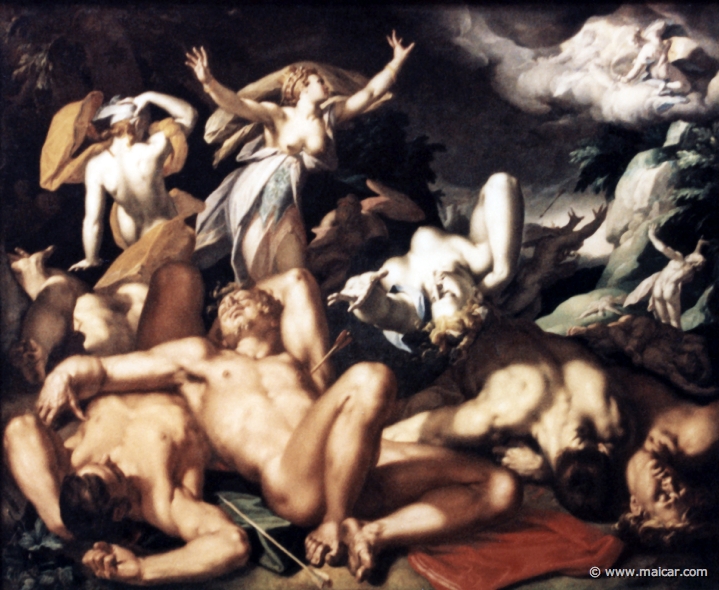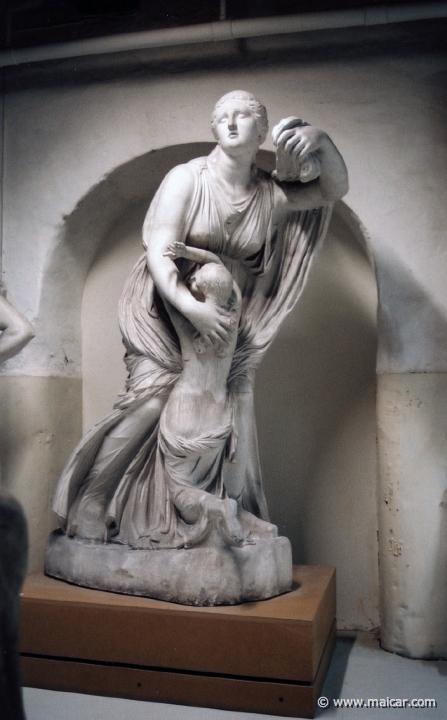|

|
From the right corner above, Apollo and Artemis shoot the NIOBIDS. 0511: Apollo and Artemis punish Niobe by killing her children. Painting by Abraham Bloemaert 1566-1655. Künsthistorische Museum, Wien.
|
|
|
"So one might believe that Lycaon was turned into a beast, and
Niobe, the daughter of Tantalus, into a stone. But at the present time, when sin has grown to such a height and has been spreading over every land and every city, no longer do men turn into gods, except in the flattering words addressed to despots, and the wrath of the gods is reserved until the sinners have departed to the next world…Similarly too it is said that Niobe on Mount Sipylus sheds tears in the season of summer. I have also heard that the griffins have spots like the leopard, and that the Tritons speak with human voice, though others say that they blow through a shell that has been bored. Those who like to listen to the miraculous are themselves apt to add to the marvel, and so they ruin truth by mixing it with falsehood." (Pausanias, Description
of Greece 8.2.5).
|
|
The NIOBIDS were the children of King Amphion 1 of Thebes and his wife Queen Niobe 2. Niobe 2 provoked with her insults the wrath of the children of Leto, Apollo and Artemis, who shot most
of the NIOBIDS with their arrows, which in other
words means that the Royal House was left desolate
by plague.
King Amphion 1
When Amphion 1 and his twin brother Zethus killed the Theban usurper Lycus 5, who had governed the city for twenty years, they did not restore Laius 1 to the throne,
though he was the legitimate king, being a
descendant of Cadmus, the
founder of the city. Instead, taking the power for
themselves, they decided that Amphion 1 should be
king.
The stones follow the lyre
And either because usurpers are fond of
fortifications, or for another reason, Amphion 1 proceeded to
build up the walls of Thebes, and they say this
was done in the most marvellous way, because the
stones with which the walls and the new gates were
built followed by themselves the music that Amphion 1 played with his lyre. It is also during this time that the city came
to be called Thebes,
after Thebe, childless wife of Zethus and the twin
sister of Aegina, mother of Aeacus, father of Peleus, father of Achilles.
Amphion 1 marries Niobe 2
Amphion 1 married Niobe 2, daughter of impious Tantalus 1, the king of Paphlagonia in Asia Minor who was expelled by Ilus 2, the founder of Troy. This is the same Tantalus 1 who is
still being punished in Hades because of the
crimes he committed against the gods.
The NIOBIDS
As the new Theban royal family prospered, Amphion 1 and Niobe 2 had children. Some say they had twenty children, others say fourteen, others twelve, others ten, and still others affirm that Niobe 2 was mother of only two males and three females. Generally, half of these children are thought to be sons, the other half daughters. In any case, this was a mother who felt she had many reasons to be proud of, for to power and wealth had been added a flourishing offspring, sons and daughters of hers and her king, who was an accomplished magician, for no one or very few can build a wall just by playing the lyre. But arrogance loves to go in the train of power and wealth, and the greater the fortune the more difficult is to see how its splendor could be destroyed. So Niobe 2 began to wonder how people could be so ridiculous to worship the power and wealth of the gods, which is of an invisible kind, instead of being devoted to the tangible things they had in front of their eyes. That is why she thought it convenient to introduce reforms in the religious rites and ordinances, so that their subjects could attain a more down to earth form of understanding, and coming to the temple of Leto, mother of Apollo and Artemis, she addressed the worshippers:
"What madness
this, to prefer gods whom you have only heard of to
those whom you have seen?" (Niobe 2. Ovid, Metamorphoses 6.170).
And after displaying her own family tree, she
explained to the people that in her palace there
were great stores of wealth, that her own beauty
was worthy of a goddess, and that whatever story
had been told about Leto, it could not be compared with the splendor of her own biography. For, among other things, while she Niobe 2 had many children, Leto had but two, and
somewhat ridiculous too, since Artemis was girt in a man's attire, and Apollo wore long hair and used a woman's robe. And to remind them that her words were backed by power, Niobe 2 ordered the worshippers to take off the laurel wreaths from their hair, and leave the temple. So those who prayed, fearing religious intolerance, left the temple without a word, but as it often happens, with unchanged mind.
|

|
Niobe 2 protecting her youngest daughter.
8626: Niobe and her youngest daughter, Roman copy of Greek work from 4C or 2C BC. Firenze, Galleria d. Uffizi (Royal Cast Collection, Copenhagen).
|
|
Gods, not men, punish Niobe 2's insults
Now, blasphemy can only be punished by the gods themselves, for mortals, no matter how wise and pious, cannot know but very little about the gods, and even less about the ways and the will of the gods. And that is why it is presumptuous to believe that a mortal could be of any help to an immortal, or able to save the reputation of a god. So the Thebans, knowing this, did not revolt
against their queen, nor did other rulers declared
war against Thebes, nor anybody dared to put a prize to Niobe 2's head. But the sweet children of Leto, Apollo and Artemis,
swiftly took upon their own responsability to
avenge their insulted mother.
Death of the NIOBIDS
And coming down from heaven, they shot their arrows from afar against Niobe 2's children, who one after the other fell dead. During nine days the NIOBIDS lay in pools of blood, for there was no one to bury them because Zeus had turned the people into stone. So it was only in the tenth day that the gods buried them themselves, and then Niobe 2, who was exhausted because of her grief, started eating again.
Survivors
However, some have said that not all of them perished, the Niobids Amyclas 2 and Chloris 1 having been spared by the gods because of their prayers to Leto. Chloris 1, who never lost the paleness that the fright caused her, became queen of Pylos in Messenia after having
married Neleus, and their
son Nestor was granted by Apollo an unusual long life because the god wished to give back the years he had taken from these young men and women. But then again some believe that no one
survived, and that is why Achilles says:
"Though they
were only two, yet they gave all to destruction." (Achilles to Priam 1. Homer, Iliad 24.609).
Death of the twins
That was the end of the house of Amphion 1, who killed
himself because of grief at the death of his
children; and as some add, he is also being
punished in Hades for
having mocked Leto and her
children. Also Zethus, Amphion 1's twin
brother died, as they say, of a broken heart.
Eternal mourning
The NIOBIDS were buried at Thebes, but Niobe 2 left the city after the death of her children, and went to her father's place at Sipylus, near Smyrna in Asia Minor, where she was transformed by Apollo into a stone from which tears flow night and day. Those who have been at this place in Mount Sipylus affirm that the rock lacks any resemblance to a woman when the observer is close to it, but that going further away one can see the form of a woman in tears, with her head bowed down. Niobe 2's mourning became proverbial, and some, impressed by her eternal weeping, have count her divine.
|